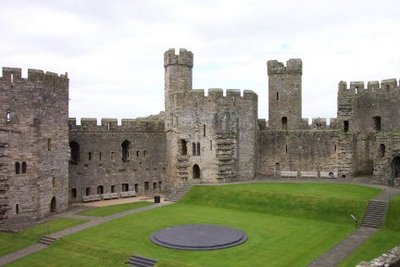Caernarfon Castle

Mighty Caernarfon is possibly the most famous of Waless many castles. Its sheer scale and commanding presence easily set it apart from the rest and, to this day, still trumpet in no uncertain terms the intentions of its builder, Edward I.
Castle Ditch, Caernarfon, Gwynedd, LL5 2AY

Of the four castles in northern Wales built by order of Edward I, Caernarfon Castle is the most magnificent. The grandeur Caernarfon Castle displays signifies King Edward I's intent that it should serve as the powerful seat of English government in Wales. Building work commenced in 1283 and continued for some fifty years.

Caernarfon Castle was constructed in the form of two baileys, joined to create a figure eight shape, and completed part of a large defence wall that enclosed the town of Caernarfon. Adjoining the nine curtain walls of the castle are a series of polygonal towers which distinguish this castle from Edward's other Welsh castles. The eastern bailey of Caernarfon Castle - the Upper Ward - contains the Black Tower, Queen's Gate, Northeast Tower and Granary Tower, and the Lower Ward, to the west, houses the Well Tower, Eagle Tower and Queen's Tower. Where the baileys meet, there is the King's Gate to the north, which provided an entrance to the castle from the town, and the Chamberlain Tower to the south.
During the first phase of building, a ditch was created to separate the town to the north from Caernarfon Castle to the south, and the moat was excavated. The town walls were completed within the first two years, along with the majority of the castle's curtain walls. In 1294 the people of Wales revolted against the English administration of the town. Once the town walls were breached, the ditch afforded the castle little protection and consequently Caernarfon suffered severe damage during the revolt. Following this invasion, the second phase of building work commenced to strengthen Caernarfon Castle's defences. Firstly, the north curtain wall was constructed, then a series of secondary barriers - including a drawbridge, five doorways and six portcullises - were installed, before final access to the Lower Ward was possible via a second drawbridge. A statue of King Edward II, the first English Prince of Wales, was erected in 1321 and can be seen above the entrance at the King's Gate.
At the same time as the new defence work was being undertaken, the timber-framed 'Hall of Llywelyn', originally situated at Conwy, was shipped to Caernarfon and erected within the castle. One of the three-storey towers along the northern wall - The Eagle Tower - served as the main living quarters, and this significance was denoted by three turrets (and a stone eagle added at the end of the 13th century). This polygonal, ten-sided tower has a strange legend attached to it concerning the bands of colour used in the walls: reputedly copied from the walls of Constantinople to commemorate the fact that Constantine the Great was born at the nearby Roman fort. The Queen's Tower, almost identical to the Eagle Tower, currently houses the regimental regalia of the Royal Welsh Fusiliers, dating back to 1689. The Queen's Gate was never fully completed, as indeed was the case with many of the castle buildings, because some of the original plans were never implemented.
This huge, old fortress has survived remarkably in tact for almost seven centuries, although only foundations survive of many of the courtyard buildings. Caernarfon Castle is an awesome and powerful sight, and its vast structure still overshadows the town as it sits defiantly along the banks of the River Seiont. It is also a magical place for exploration with its labyrinth of covered passageways and exciting wall walks.










0 Comments:
Post a Comment
<< Home